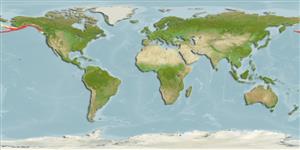Environment: milieu / climate zone / depth range / distribution range
Écologie
marin démersal; non migrateur; profondeur 0 - 452 m (Ref. 50550), usually 100 - 150 m (Ref. 56580). Temperate; 1°C - 9°C (Ref. 56580); 62°N - 46°N, 171°E - 121°W (Ref. 57307)
North Pacific: Sea of Okhotsk, Sea of Japan (Ref. 559), Kuril Islands (Ref. 56580) and the Bering Sea to Puget Sound, Washington, USA.
Taille / Poids / Âge
Maturity: Lm ? range ? - ? cm
Max length : 12.0 cm TL mâle / non sexé; (Ref. 56580); common length : 10.0 cm TL mâle / non sexé; (Ref. 56580); poids max. publié: 24.00 g (Ref. 56580); âge max. reporté: 7 années (Ref. 56580)
Épines dorsales (Total): 8 - 11; Rayons mous dorsaux (Total): 5-7; Épines anales 0; Rayons mous anaux: 8 - 11; Vertèbres: 35 - 37. Lower lobe of pectoral fin with 7 to 8 free rays. A barbel is present on the tip of the snout. Dorsum highly elevated at nape. Branchial membrane free from isthmus. Supralateral and infralateral plates attached to each other on lateral line. Dorsal fins close to each other. Lateral line plates less than 15.
Rocky sand, gravel, or pebble bottoms. Frequently covered by featherlike polyps (small hydroid animals) (Ref. 2850).
Life cycle and mating behavior
Maturité | Reproduction | Frai | Œufs | Fécondité | Larves
Eschmeyer, W.N., E.S. Herald and H. Hammann, 1983. A field guide to Pacific coast fishes of North America. Boston (MA, USA): Houghton Mifflin Company. xii+336 p. (Ref. 2850)
Statut dans la liste rouge de l'IUCN (Ref. 130435)
Menace pour l'homme
Harmless
Utilisations par l'homme
Plus d'informations
RéférencesAquacultureProfil d'aquacultureSouchesGénétiqueElectrophoresesHéritabilitéPathologiesTraitementNutrientsMass conversion
CollaborateursImagesStamps, Coins Misc.SonsCiguateraVitesseType de nageSurface branchialeOtolithesCerveauxVision
Outils
Articles particuliers
Télécharger en XML
Sources Internet
Estimates based on models
Preferred temperature (Ref.
123201): 3.5 - 7.2, mean 5.4 °C (based on 78 cells).
Phylogenetic diversity index (Ref.
82804): PD
50 = 0.7500 [Uniqueness, from 0.5 = low to 2.0 = high].
Bayesian length-weight: a=0.00479 (0.00187 - 0.01224), b=3.06 (2.84 - 3.28), in cm total length, based on LWR estimates for this (Sub)family-body shape (Ref.
93245).
Niveau trophique (Ref.
69278): 3.2 ±0.1 se; based on size and trophs of closest relatives
Résilience (Ref.
120179): Haut, temps minimum de doublement de population inférieur à 15 mois (Preliminary K or Fecundity.).
Fishing Vulnerability (Ref.
59153): Low vulnerability (10 of 100).
